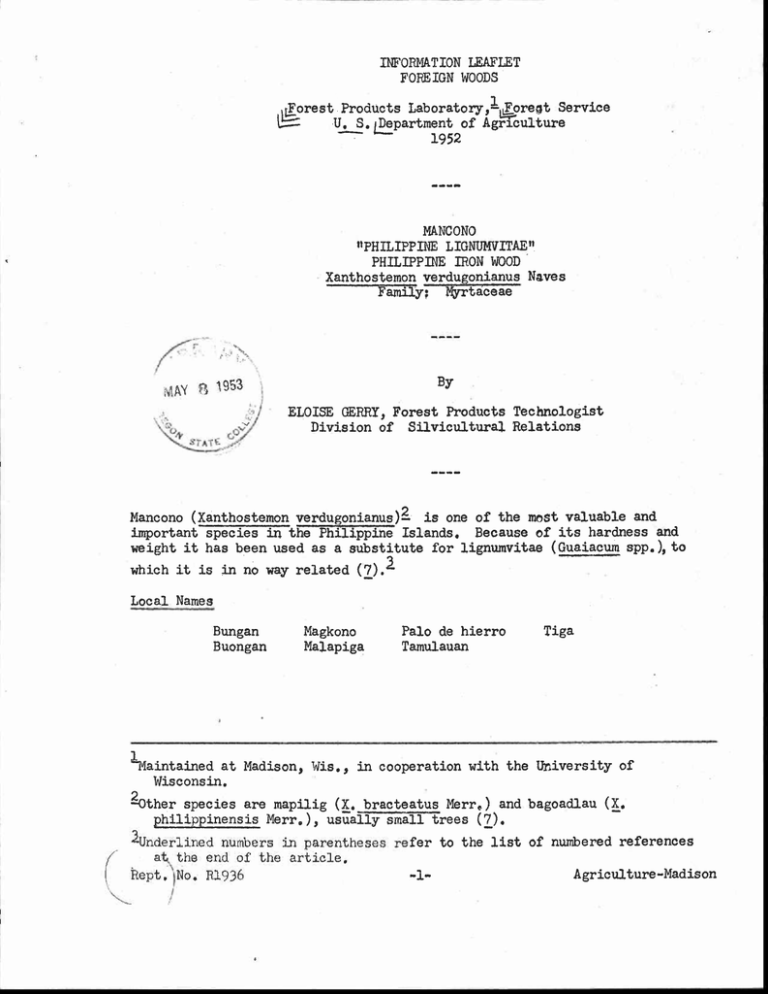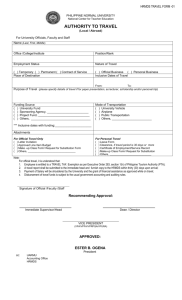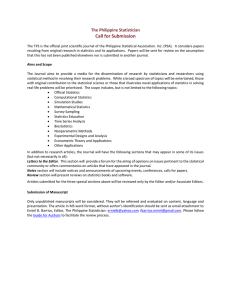INFORMATION LEAFLET FOREIGN WOODS aForest.ProdUcts Laboratory, 1
advertisement

INFORMATION LEAFLET FOREIGN WOODS aForest.ProdUcts Laboratory, 12oreat Service partment of Agriculture U.S.• lt,== 1952 .1 MID 41•111 MANCONO "PHILIPPINE LIGNUMVITAE" PHILIPPINE IRON WOOD Xanthostemon verdugonianus Naves Family; Myrtaceae By ELOISE GERRY, Forest Products Technologist Division of Silvicultural Relations Mancono (Xanthostemon verdugonianus)a is one of the most valuable and important species in the Philippine Islands. Because of its hardness and weight it has been used as a substitute for lignumvitae (Guaiacum spp.), to which it is in no way related (7).2 Local Names Bungan Buongan Magkono Malapiga Palo de hierro Tamulauan Tiga Maintained at Madison, Wis., in cooperation with the University of Wisconsin. -Other species are mapilig (X. bracteatus Merr.) and bagoadlau (X. philippinensis Merr.), usually small trees (7). -Underlined numbers in parentheses refer to the list of numbered references a the end of the article, Agriculture-Madison hept. No. R1936 -1- Distribution Although mancono occurs rather widely, the supply is somewhat The tree is best known in Surigao, Sibuyan, and Agusan in the Islands, but occurs also in Busuanga, Culion, Palawan, Samar, Panay, Tinago, Dinagat, and Mindanao. Other species of this found in New Guinea (5, 7). limited. Philippine Leyte, genus are The Tree Mancono produces a small to medium size: tree, that may attain 60 inches in diameter with 30 feet of main stem, The trunk is generally short but regular. The branches may extend down to 3 to 6 feet from the ground. The bark is thin, smooth, and very hard (5, 7). The Wood Color Mancono sapwood is 1/2 to 1 inch in width and light brown in color, not sharply demarcated from the reddish brown heartwood that has a grayish tinge and darkens with age (5, 7). Grain and Texture The wood is generally cross-grained, sometimes twisted or wavy. The texture is fine (7). Luster The wood may be given a smooth finish and then presents a glossy appearance (7). Odor and Taste Odor and taste are not distinctive (7). Weight Mancono is one of the heaviest Philippine woods. The specific gravity air dry is 1411, Weight per cubic foot of 115 pounds at 60 to 80 percent moisture content (green), or 88 pounds at 15-17 percent moisture content is recorded. Rept. No. R1936 -2- At 15 to 17 percent moisture content 1,000 board feet weigh 7,333 pounds (7). Mechanical Properties Mancono is very hard and strong (7). The genus is reported to contain silica inclusions in the central ray cells (1). Seasoning The ends of logs are subject to severe checking, but painting them with tar or heavy oil serves to help control it. Freshly sawn material may develop shallow checks (7). Workability Mancono is rated as difficult to work. It is usually cut up while green (7). Durability The heartwood is rated as highly durable; even under the most severe conditions, it is one of the most durable Philippine species (7). Structure The pores are mostly isolated, diffuse, small, moderately numerous, filled with tyloses, and contain dark red gummy deposits or softer yellow deposits. The rays are narrow, numerous, lighter in color than the surrounding tissue, and may contain silica. The fibers are extremely dense (1, 7). Uses Mancono is used for posts, saltwater piling, tool handles, bowling balls, dumb-bells, paper weights, and other novelties. It has been tried with some success (7) for the exacting uses for which lignumvitae is valued because of its oily content. It is said, however, to be unsuitable for stern tube bearings of ships because its use results in excessive wear on the propeller shaft, (Silica has been reported in Xanthostemon rays (1).) The wood is reported to be unsatisfactory for bowling balls (2). Rept. No. 81936 -3- References 1. Amos, G. L. 1952. Silica in Timbers. Pp. 26-27, Bull. No. 267, Commonwealth Research Organ., Melbourne, Australia, & Indus. 2. Brush, W. D. 1938. Lignumvitae. Foreign Woods Leaflet p. 11, Forest Service, U. S. Dept. Agr., Washington, D. C. 3. Dadswell, H. E. 1945 • Timbers of the New Guinea Region Tropical Woods No. 83, pp. 8, 11, 14, New Haven, Conn. 4. Guillaumin, A. 1934. Materiaux pour la flora de la Nouvelle-Caledonie XXXIV. Revision des Myrtaeees a fruit sec etc. (Keys) Bull. Soc. Bot. France (Paris) 81:3-17. (Rev. Trop. Woods 39:67, 1934) 5. Kraemer, J. H. 1951. Trees of the Western Pacific Region. Pp. 362-363, illus. West Lafayette, Ind. (For sale by Tri-State Offset Co., 817 Main St., Cincinnati, Ohio, $5.50) 6. Pampanini, R. and Pampaloni, L. 1905-6. Contribuzione alla conoscenza del genera Xanthostemon F. Muell. Nuovo Giorn. Bot. Ital. II 121673-688, 13:121-137, f. 1-4. (Includes app. from New Caledonia) 7. Reyes, L. J. 1938. Philippine Woods. Tech. Bull. 7, pp. 383-385, Manila. Rept. No. 81936 -4-






